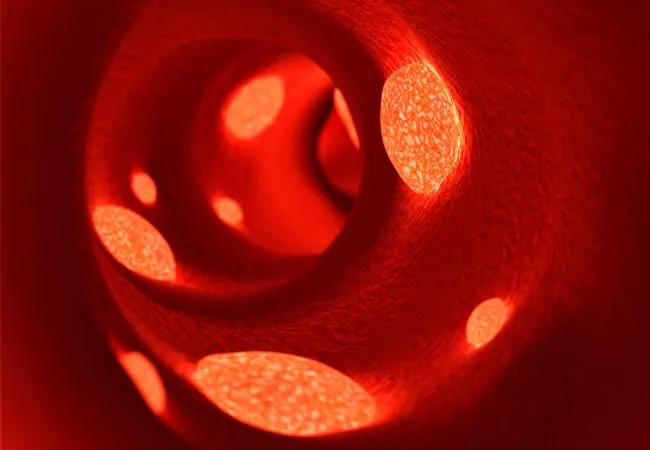Patients with a prior history of VTA are at an increased risk of subsequent incidents, despite treatment with therapeutic anticoagulation

A recent analysis of patients with multiple myeloma, led by Cleveland Clinic researchers, found that the biggest risk factor of venous thromboembolism (VTE) during the immediate peri-autologous hematopoietic cell transplantation phase is a prior history of the condition, underscoring the importance of monitoring these patients.
Advertisement
Cleveland Clinic is a non-profit academic medical center. Advertising on our site helps support our mission. We do not endorse non-Cleveland Clinic products or services. Policy
VTE, or blood clots in the veins, is a serious yet often under-diagnosed condition, and is the second most likely cause of mortality among cancer patients. Individuals with multiple myeloma are at an increased risk of developing VTE and the risk is even higher for those undergoing autologous hematopoietic cell transplant (AHCT).
“We have observed firsthand the impact of venous thromboembolism and its prominence in all types of cancers, but especially among patients with multiple myeloma,” says Hussein Awada, MD, Department of Translational Hematology and Oncology Research, Taussig Cancer Institute, Cleveland Clinic, while noting that recent research also suggests that this condition can be further exacerbated in patients treated with immunomodulatory agents.
Dr. Awada, alongside his colleagues at the Cleveland Clinic, sought to gain a better understanding of the incidence of VTE in patients with multiple myeloma undergoing AHCT as well as risk factors and potential preventive measures.
This study explored venous thromboembolism among patients with multiple myeloma in the peri-AHCT setting, which was defined by the researchers as “extending from hematopoietic progenitor cell (HPC) mobilization up to 30 days post-autologous hematopoietic cell transplant.”
The analysis included 493 patients, and the study authors identified symptomatic VTE in 23 events involving 17 patients (3.5%). Of these VTE events, 11 (47.83%) occurred between mobilization and time of hospitalization for AHCT, three (13.04%) during hospitalization and nine (39.13%) happened post-discharge.
Advertisement
Data showed that the majority of venous thromboembolism events were non-catheter related (95.65%). Dr. Awada and colleagues observed lower extremity deep venous thromboses (DVT) in 12 events (52.2%), pulmonary embolisms in four events (17.4%), upper extremity deep venous thromboses in three events (13%), internal jugular thromboses in three events (13%) and superficial vein thrombosis in one event (4.4%).
Among patients included in this study, seven had a history of previous VTE and 15 (88.2%) were previously on immunomodulatory drugs (IMiD). Four patients (23.5%) were on aspirin only, six were on anticoagulant therapy only (35.3%) and three were on a combination of both (17.7%).
Eleven (64.7%) female patients and six (35.3%) male patients developed VTE. Patients with VTE were more likely to have a Hematopoietic Cell Transplantation-specific-Comorbidity Index (HCT-CI) of one or greater compared to those without the condition (100% vs. 79.4%) as well as neutropenia (12.5 vs. 3%) and a history of prior VTE (41.2% vs. 11.6%).
The multivariate analysis confirmed that females and patients with a prior history of VTE had a higher risk of developing the condition during the peri-transplant period, according to Dr. Awada.
“Despite most of these patients being on anticoagulants, individuals with a prior history of VTE had an increased risk of another episode during this period; therefore, these patients should be more closely monitored,” he notes.
When examining patients with no prior history of VTE, data showed that patients who did not experience a VTE event were more likely to be on either aspirin or prophylactic anticoagulation (82.6% vs. 50%). Notably, the researchers did not observe any difference in the incidence of VTE with aspirin versus prophylactic anticoagulation among patients without a prior history of the condition.
Advertisement
“This, in our opinion, is very important,” says Dr. Awada. “Every patient who comes into the hospital is at an increased risk of developing VTE because they are bedridden and typically we will administer prophylactic anticoagulation to prevent this during hospitalization.
“However, due to treatment, patients with multiple myeloma can develop low platelets and are at a high risk of bleeding. So, we try to avoid even lower doses of anticoagulants,” he adds. “Our finding that the incidence of VTE is similar with an anti-platelet like aspirin or an anticoagulant such as Heparin suggests that aspirin might actually be a safer option—with similar efficacy—in individuals with low platelets.”
Overall, this research suggests that the risk of VTE is low among patients with multiple myeloma in the peri-transplant period at approximately 3.5%. “Our data underscores the importance of monitoring these patients peri-transplant phase, especially those with a prior history of VTE,” notes Dr. Awada. “Additionally, anti-platelets are as effective as prophylactic anticoagulation for the prevention of this condition in patients with no prior history of VTE. This may be an effective alternative option for clinicians to consider when caring for this patient population.”
Advertisement
Advertisement

An updated review of risk factors, management and treatment considerations

Oral anticoagulants may be beneficial but need to be balanced against bleeding risks

Redesigned protocols enhance infection-prevention measures

Enhanced visualization and dexterity enable safer, more precise procedures lead to better patient outcomes

Phase 2 study brings pivotal advances in treatment efficacy and safety for the most challenging-to-treat population

Insights on bringing Cleveland Clinic even closer to becoming the best transplant enterprise in the world

Potentially cost-effective addition to standard GERD management in post-transplant patients

Consensus statement aims to increase use of the perfusion technology and raise transplant volumes